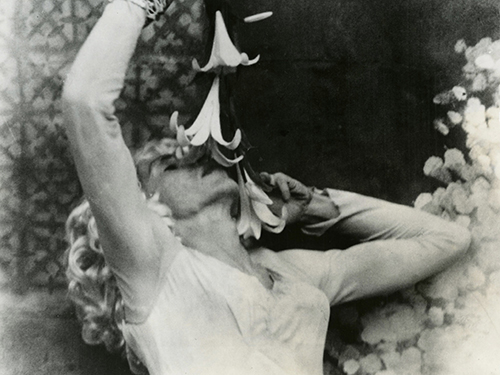
In this, his best known film, characters cavort in a setting reminiscent of the court of Ali Baba, with a mood suggestive of the paintings of Hieronymous Bosch. The film is a quasi-documentary of Androgynes and Transvestites in which flaccid penises and bouncing breasts are so ambiguously equated as to disarm any distinction between male and female. In Flaming Creatures, Smith manages to combine the ornate imagination of his youth with the realities of adult fantasy.
“In Flaming Creatures Smith has graced the anarchic liberation of new American cinema with graphic and rhythmic power worthy of the best of formal cinema. He has attained for the first time in motion pictures a high level of art which is absolutely lacking in decorum; and a treatment of sex which makes us aware of the restraint of all previous film-makers.”
Jonas Mekas1
“The only thing to be regretted about the close-ups of limp penises and bouncing breasts, the shots of masturbation and oral sexuality, in Jack Smith’s Flaming Creatures is that they make it hard simply to talk about this remarkable film; one has to defend it. But in defending as well as talking about the film, I don’t want to make it seem less outrageous, less shocking than it is. [...]
As it happens, Flaming Creatures is not pornographic, if pornography be defined as the manifest intention and capacity to excite sexually. The depiction of nakedness and various sexual embraces (with the notable omission of straight screwing) is both too full of pathos and too ingenuous to be prurient. Rather than being sentimental or lustful, Smith’s images of sex are alternately childlike and witty. [...]
The truth is that Flaming Creatures is much more about intersexuality than about homosexuality. Smith’s vision is akin to the vision in Bosch’s paintings of a paradise and a hell of writhing, shameless, ingenious bodies. Unlike those serious and stirring films about the beauties and terrors of homoerotic love, Kenneth Anger’s Fireworks and Genet’s Chant d’Amour, the important fact about the figures in Smith’s film is that one cannot easily tell which are men and which are women. These are ‘creatures,’ flaming out in intersexual, polymorphous joy. The film is built out of a complex web of ambiguities and ambivalences, whose primary image is the confusion of male and female flesh. The shaken breast and the shaken penis become interchangeable with each other. Bosch constructed a strange, aborted, ideal nature against which he situated his nude figures, his androgynous visions of pain and pleasure. Smith has no literal background (it’s hard to tell in the film whether one is indoors or outdoors), but instead the thoroughly artificial and invented landscape of costume, gesture, and music. The myth of intersexuality is played out against a background of banal songs, ads, clothes, dances, and above all, the repertory of fantasy drawn from corny movies. The texture of Flaming Creatures is made up of a rich collage of ‘camp’ lore: a woman in white (a transvestite) with drooping head holding a stalk of lilies; a gaunt woman seen emerging from a coffin, who turns out to be a vampire and, eventually, male; a marvelous Spanish dancer (also a transvestite) with huge dark eyes, black lace mantilla and fan; a tableau from the Sheik of Araby, with reclining men in burnooses and an Arab temptress stolidly exposing one breast; a scene between two women, reclining on flowers and rags, which recalls the dense, crowded texture of the movies in which Sternberg directed Dietrich in the early thirties. The vocabulary of images and textures on which Smith draws includes pre-Raphaelite languidness; Art Nouveau; the great exotica styles of the twenties, the Spanish and the Arab; and the modern ‘camp’ way of relishing mass culture.”
Susan Sontag2
“Frequently banned, this notorious American avant-garde work is a curiously joyless compendium of uncertain, polymorphously perverse sex episodes -- a succession of penises, rapes, orgies, masturbation, and oral sex. The style, quite intentionally, hovers between "camp" satire and genuine pain, as a cast of flaming transvestites and voluptuous women cavort in exaggerated costumes (or none) amidst luxuriant, over-exposed sets, fondling each other's large breasts and limp penises to the doleful accompaniment of scratchy bull-fight or Chinese music, "Siboney", and assorted sentimental hits. Perhaps a nostalgic, subjective dream evocation of a mythological Hollywood, it succeeds in being both intentionally amateurish and shocking.”
Amos Vogel3
“At once primitive and sophisticated, hilarious and poignant, spontaneous and studied, frenzied and languid, crude and delicate, avant and nostalgic, gritty and fanciful, fresh and faded, innocent and jaded, high and low, raw and cooked, underground and camp, black and white and white on white, composed and decomposed, richly perverse and gloriously impoverished, Flaming Creatures was something new. Had Jack Smith produced nothing other than this amazing artifice, he would still rank among the great visionaries of American film.”
J. Hoberman4
- 1Jonas Mekas (editorial), “Fifth Independent Film Award.” Film Culture 29 (1963): 1.
- 2Susan Sontag, Against Interpretation (New York, Picador: 1966), 159 -161.
- 3Amos Vogel, Film as Subversive Art (New York: Random House, 1974).
- 4J. Hoberman, “The Big Heat: The Making and Unmaking of Flaming Creatures,” Edward Leffingwell, et al, Flaming Creature: Jack Smith: His Amazing Life and Times, (London: Serpent’s Tail, 1997) 155. Via Senses of Cinema.

